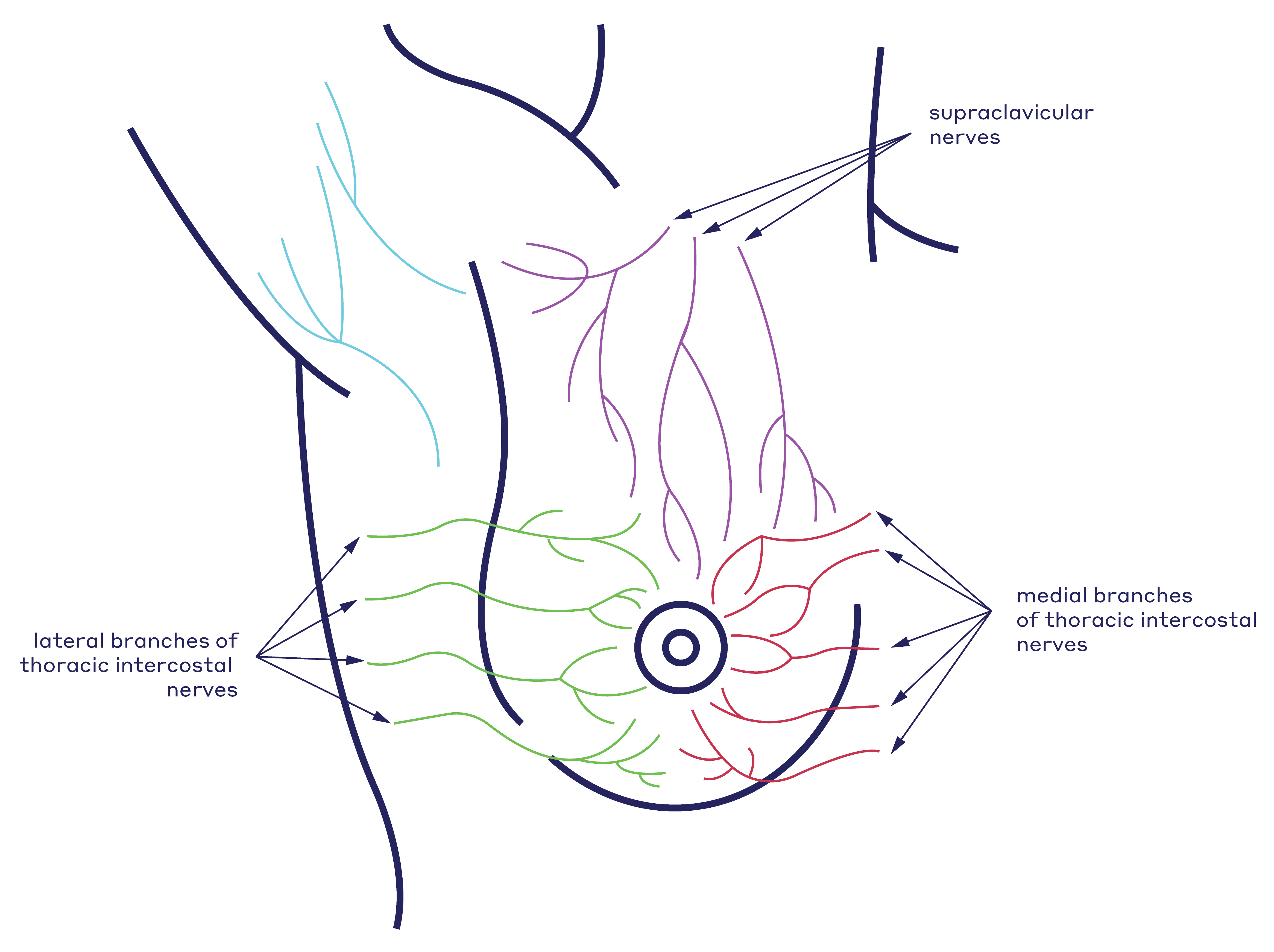Why do women lose breast sensation after mastectomy?

There are sensory nerves that run from your breast to the brain, sending messages that allow you to feel touch, temperature—even pain. But these nerves need to be cut during a mastectomy so the breast tissue can be removed. If the nerves aren’t repaired during breast reconstruction, they no longer send signals. No signal means no sensation. This usually results in numbness and loss of feeling in the breast area.
How does losing breast sensation after mastectomy affect women?
Loss of sensation after mastectomy can have a negative impact on quality of life. Think of how it feels when your mouth is numbed at the dentist. Or the weird sensation of bumping your foot after it’s fallen asleep and you realize you can’t feel it. Numbness in your chest may be similar. Without the ability to detect touch, you might have a somewhat disconnected sense of your chest. Cuts, rashes, sharp objects—you might not feel any of it. Research has shown that loss of breast sensation can affect body image and psychological health, as well as risk of injury.1,2 For many women, breasts they cannot feel do not feel like their own.3
Losing sensation can also make it difficult to move past your mastectomy and start to feel whole again.4
- https://www.ncbi.nlm.nih.gov/pmc/articles/PMC5351438/
- https://journals.lww.com/prsgo/fulltext/2016/10000/Thermal_Injury_to_Reconstructed_Breasts_from.8.aspx
- https://www.cancer.org/cancer/breast-cancer/reconstruction-surgery/what-to-expect-after-breast-reconstruction-surgery.html
- Axogen Corporation. More than skin deep: loss of sensation after mastectomy significantly impacts women’s quality of life. Axogen Corporation. 2021.
What is Resensation®?
Resensation is a surgical technique performed during breast reconstruction that allows surgeons to reconnect nerves cut during a mastectomy using allograft nerve tissue. Over time, the nerve fibers regenerate, becoming a part of the woman’s own body. As the nerve fibers grow, they have the potential to gradually restore sensation to the breasts.
When is Resensation performed?
Resensation is performed at the same time as breast reconstruction.
Resensation can be performed during an immediate reconstruction (at the same time as the mastectomy) or a delayed reconstruction (months or years after the mastectomy). Additionally, Resensation may also be possible if you are considering a revision to a previous implant reconstruction. You and your plastic surgeon can determine the right timing based on your desires, medical condition and cancer treatment.
Why is Resensation a potentially important advancement for women after mastectomy?
Historically, sensory nerves were not repaired during breast reconstruction surgery, leaving women with limited to no return of sensation. Though reconstructed breasts can achieve cosmetically desirable results – size, shape, softness and symmetry – women typically cannot feel touch or temperature in the chest area after reconstruction. The Resensation technique allows the breast reconstruction surgeon to potentially restore lost sensation by reconnecting nerves severed during mastectomy.
What are the potential benefits of returning sensation to the breasts?
Studies suggest that breast neurotization may provide a variety of benefits in terms of physical safety, body image, emotional health and overall quality of life.5 For example, a recent study found that neurotization had a positive impact on women’s quality of life after mastectomy. Specifically, the study found that women who had neurotization reported a greater sense of physical well-being of the chest than women who did not have neurotization. Women with neurotization were also more likely to report their reconstructed breasts “felt like their own.”6
Women report that regaining sensation helps them recover and move on from their experience with cancer, the mastectomy and the reconstruction process. It also helps them feel more normal and more like their old selves.7
- https://insights.ovid.com/crossref?an=00006534-200911000-00006
- https://link.springer.com/article/10.1007/s10549-017-4547-3
- Crohan S, Campbell A. Breast sensations research report. Inspired Health. October 2020. Report on file at Axogen.
What type of surgeon performs Resensation?
Not all surgeons know about or can perform Resensation.
You’ll need a plastic reconstructive surgeon who has expertise in microsurgery and is skilled at using microscopes and precision instrumentation to repair blood vessels, nerves and other intricate structures.
To find a surgeon who performs Resensation near you, visit the Resensation surgeon locator and browse providers by state.
Am I a candidate for Resensation?
Talk to your plastic surgeon to see if you are a candidate, but keep in mind that many surgeons do not yet offer Resensation. Find a surgeon who offers the Resensation surgical technique by using our locator.
How long does it take to restore some level of feeling after breast neurotization?
It takes time for nerves to heal and grow after breast neurotization. Nerves typically grow 1-2 millimeters a day8 (For comparison, a dime is about 1 millimeter thick.)
Plastic surgeons who perform the procedure report that women typically start to regain sensation several months after neurotization and the feelings can continue to develop for up to two years.9 Axogen is leading the effort to collect more data on outcomes through our Sensation-NOW™ registry.
- Grinsell D, Keating CP. Peripheral nerve reconstruction after injury: a review of clinical and experimental therapies. Biomed Res Int. 2014;2014:698256. doi:10.1155/2014/698256
- https://insights.ovid.com/pubmed?pmid=11994590
Where can I find a surgeon who performs Resensation?
Breast neurotization with Resensation is performed by a growing number of plastic surgeons with expertise in microsurgery. Find a surgeon who offers breast neurotization using our Resensation locator.
Is Resensation covered by insurance?
Breast reconstruction is a covered procedure; however breast neurotization coverage may differ by insurer. Coverage is determined on a case by case basis by the insurer, which typically requires the surgeon to secure pre-authorization in advance of the procedure.